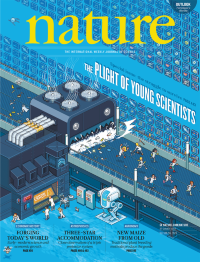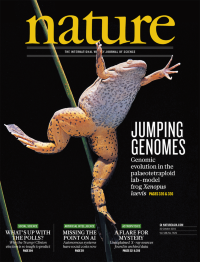Volume 538
-
No. 7626 27 October 2016
This special issue of Nature explores some of the concerns of early-career scientists by attempting to give them a voice. We talk to young researchers battling to establish their labs, hoping to innovate and at the same time build a career when so much emphasis is placed on paper counts. And at a time when career progression is hampered by a global postdoc glut, scarce funding and the disappearance of tenure-track posts, we argue in our Editorial on page 427 that it is up to everyone in science � young and old � to ensure that the next generation of researchers is not lost.
-
No. 7625 20 October 2016
Xenopus laevis, also known as the African clawed frog or platanna. X. laevis is an important model organism that is used in the study of vertebrate cell and developmental biology. It is a palaeotetraploid the product of genome duplications that occurred many millions of years ago. This makes X. laevis ideal for the study of polyploidy, but has greatly complicated genome sequencing. In this issue of Nature an international research collaboration reports the X. laevis genome sequence, and compares it to that of the related X. tropicalis. Their analyses confirm that X. laevis is an allotetraploid and distinguishes two subgenomes that evolved asymmetrically one often retained the ancestral state and the other was subject to gene loss, deletion, rearrangement and reduced expression. The two diploid progenitor species diverged about 34 million years ago, combining to form an allotetraploid about 18 million years ago. Cover photo: Paul Starosta/Getty Images
-
No. 7624 13 October 2016
Three international collaborations reporting in this issue of Nature describe 787 high-quality genomes from individuals from geographically diverse populations. David Reich and colleagues analysed whole-genome sequences of 300 individuals from 142 populations. Their findings include an accelerated estimated rate of accumulation of mutations in non-Africans compared to Africans since divergence, and that indigenous Australians, New Guineans and Andamanese do not derive substantial ancestry from an early dispersal of modern humans but from the same source as that of other non-Africans. Eske Willerlsev and colleagues obtained whole-genome data for 83 Aboriginal Australians and 25 Papuans from the New Guinea Highlands. They estimate that Aboriginal Australians and Papuans diverged from Eurasian populations 51,000�72,000 years ago, following a single out-of-Africa dispersal. Luca Pagani et al. report on a dataset of 483 high-coverage human genomes from 148 populations worldwide, including 379 new genomes from 125 populations. Their analyses support the model by which all non-African populations derive most of their genetic ancestry from a single recent migration out of Africa, although a Papuan contribution suggests a trace of an earlier human expansion. Cover art: A genetic improvisation on a world map� by Markus Kasemaa.
-
No. 7623 6 October 2016
Our understanding of the neural circuits controlling sleep cycles is still incomplete. The availability of new techniques in optogenetics, pharmacogenetics, microendoscopic calcium imaging and virus-mediated circuit tracingtogether with mouse geneticsraise the possibility that many of the mysteries of sleep can be tackled. In a Review in this issue of Nature, Franz Weber and Yang Dan explore the current state of sleep circuit research and plot a course directed towards an ambitious goal: a comprehensive circuit diagram of the sleepwake control network detailing the functional role of each cell type and the interactions between them. Cover: Kelly Krause/Nature � Source images: Twin Design/Shutterstock; Franz Weber & Yang Dan




